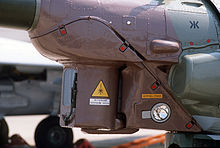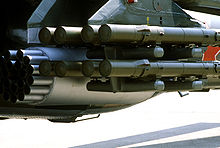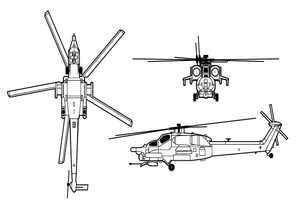- Mil Mi-28
-
Mi-28 Mil Mi-28N in flight Role Attack helicopter Manufacturer Mil First flight 10 November 1982[1] Introduction 2006 (Russia) Status Deliveries underway Primary users Russian Air Force
Venezuelan ArmyNumber built 48 Unit cost € 12 million[2] The Mil Mi-28 (NATO reporting name 'Havoc') is a Russian all-weather day-night military tandem two-seat anti-armour attack helicopter. It is a dedicated attack helicopter with no intended secondary transport capability, better optimized than the Mil Mi-24 for the role. It carries a single gun in an undernose barbette, plus external loads carried on pylons beneath stub wings.
Contents
Development
In 1972, following completion of the Mil Mi-24, development began on a unique attack helicopter with transport capability. The new design had a reduced transport capability (3 troops instead of 8) and omitted the cabin, to provide better overall performance and higher top speed. Improved performance was important for its intended role fighting against tanks and enemy helicopters and covering helicopter landing operations. Initially, many different designs were considered, including an unconventional project with two main rotors, placed with engines on tips of wings (in perpendicular layout), and with an additional pusher propeller on the tail. In 1977, a preliminary design was chosen, in a classic single-rotor layout. It lost its similarity to the Mi-24, and even the canopies were smaller, with flat surfaces.
Design work began on the Mi-28 began under Marat Tishchenko in 1980.[3] In 1981, a design and a mock-up were accepted. The prototype (no. 012) was first flown on 10 November 1982.[3] The second prototype (no. 022) was completed in 1983. In 1984, the Mi-28 completed the first stage of state trials, but in October 1984 the Soviet Air Force chose the more advanced Kamov Ka-50 as the new anti-tank helicopter. The Mi-28 development was continued, but given lower priority. In December 1987 Mi-28 production in Rosvertol in Rostov on Don was approved.
In January 1988 the first Mi-28A prototype (no. 032) flew. It was fitted with more powerful engines and an "X" type tail rotor instead of the three-blade version. The Mi-28A debuted at the Paris Air Show in June 1989. In 1991 the second Mi-28A (no. 042) was completed. The Mi-28A program was cancelled in 1993 because it was deemed uncompetitive with the Ka-50, and in particular, it was not all-weather capable.
Then the Mi-28N, was unveiled in 1995, the N designation meaning "night". The prototype (no. 014) first flew on 14 November 1996. The most significant feature is a radar in a round cover above the main rotor, similar to that of the American AH-64D Longbow Apache. Mi-28N also has improved Tor vision and an aiming device under the nose, including a TV camera and FLIR. Due to funding problems, development was interrupted. A second prototype with an improved rotor design was unveiled in March 2004 at Rosvertol.
Changes in the military situation after the Cold War made specialized anti-tank helicopters, like Ka-50, less useful. On the other hand, its all-weather, two-seat variant Ka-52 had worse performance due to increased weight. The advantages of the Mi-28N, like all-weather action ability, lower cost, and similarity to the Mi-24, have become important. In 2003, the head of Russian Air Forces stated that the Mi-28N will become the standard Russian attack helicopter.[4]
The first serial Mi-28N was delivered to the Army in 2006.[5][6] By 2015 a total of 67 Mi-28Ns is planned to be purchased, when the Mi-24 is to be completely replaced.[6][7]
An export variant of the Mi-28N, designated Mi-28NE, and a simpler day-helicopter variant, the Mi-28D, based on the Mi-28N design, but lacking radar and FLIR have also been developed.
Design
The Mi-28 has two heavily armored cockpits, a windshield able to withstand hits from 7.62–12.7 mm caliber bullets, a nose equipped with electronics, and a narrow-X tail rotor (55 deg) with reduced noise characteristics. It is powered by two 2,200 hp Isotov TV-3-117VM (t/n 014) turboshaft engines.
While the Mi-28 is not intended for use as a transport, it does have a small passenger compartment capable of carrying three people. The planned purpose of this is to enable the rescue of downed helicopter crews.
The Mi-28N features a helmet mounted display for the pilot. The pilot would designate targets for the Navigator/Weapons Officer, who proceeds to fire the weapons required to fulfill that particular task.
Armament
One armament that is commonly seen amongst Mi-28s are a pair of 8 Ataka missile racks along with 2 B-13L rocket pods, each able to carry 5 S-13 rockets. Other rocket options include two B-8 rocket pods, each able to carry up to 20 S-8 rockets. The 30 mm chain gun is a staple amongst all Mi-28 combat loads.
The Atakas used have 4 variants for different tasks. The 9M120 Tandem High Explosive Anti-Tank (HEAT) warhead variant is used against tanks fitted with Explosive Reactive Armor (ERA), its penetrative ability is stated at 800 mm Rolled Homogeneous Armour (RHA).[8] The 9M120F Thermobaric variant is used against infantry, buildings, bunkers, and caves. The 9M120O expanding rod warhead variant is used against other helicopters. All the variants have a range of 6 km. The 9M120M improved version has a longer range (8 km) and better penetration (900 mm of RHA).[9] All of the variants use SACLOS missile guidance.
The S-8 and S-13 rockets used by the Mi-28 are usually unguided. In the most common configuration, one can expect 40 S-8 rockets or 10 S-13 rockets. Both rockets have their variants, from HEAT warheads to a Thermobaric warhead. The S-8 has a shorter range and smaller warhead than the S-13, but compensates with numbers. Currently, the Russian Air Force are upgrading their S-8 and S-13 rockets to laser guided[10] missiles with the proposed Ugroza ("Menace") system. Rockets upgraded under Ugroza would receive designations S-8Kor and S-13Kor, respectively.
The gun armament of the Mi-28 is the 30 x 165 mm Shipunov 2A42 Autocannon. It is a select fire, dual-feed gun, which allows for a cyclic rate of fire between 200 rounds per minute to 550 rounds per minute. Its effective range varies from 1500 meters for ground vehicles to 2500 meters for air targets. Rounds from High Explosive Incendiary (HEI) to Armour-Piercing Discarding Sabot (APDS) can be used. Stated penetration for the 3UBR8 is 50 mm of RHA at 1,500 meters.
Operational history
The Russian Army received the first Mi-28 prototypes for testing in 2004.[1] It received the first serial production Mi-28N in 2006.[5][6] That serial Mi-28N then joined two prototype helicopters for army trials. The aircraft entered service in 2006.[11] A total of 24 Mi-28s were in service with the Russian Air Force as of February 2011.[12]
On 15 February 2011 a Mi-28 crashed in southern Russian region of Stavropol. One of the pilots later died in hospital.[13][14]
Export interest
The Indian Military asked for a modified prototype of Mi-28 fitted with French and Belgian avionics. Russian manufacturers are discussing how to meet these requirements.[15] There are reports of negotiations with IAF on the Mi-28 and the Boeing AH-64D for 22 attack helicopters.[16]
Variants
- Mi-28A – Original production anti-tank helicopter. Development done in 1998, first flight in 2003.
- Mi-28N/MMW Havoc – All weather day-and-night combat helicopter. It is equipped with a top-mounted millimeter wave radar station, IR-TV, and laser ranger. Serial Mi-28N will have two Russian Klimov TV3-117V MA-SB3 engines (2,500 hp each), made in production by the Ukrainian Motor-Sich. Max take off weight of 11500 kg, max payload weight of 2,350 kg.
- Mi-28D – simplified daylight operation version. Similar to Mi-28N, but without top-mounted radar and TV-channel in sight.
- Mi-28NAe – export version offered to North Korea.[17]
- Mi-28L – proposed export version for Iraq.
- Mi-40 – armed transport version.
Operators
- Russian Air Force had 44 in operation http://www.armstrade.org/includes/periodics/news/2011/1012/10109945/detail.shtml
- Algerian Air Force was expected to place an order for 42 Mi-28NE helicopters as of June 2010.[19]
- Venezuelan Air Force had 10 Mi-28N/MMW on order in April 2010, delivery date unknown.[20]
- Soviet Air Force – Mi-28s passed onto Russian Air Force
Specifications (Mi-28N)
Data from Jane's[1]
General characteristics
- Crew: 1 pilot (rear), 1 navigator/weapons operator (front)
- Length: 17.01 m (55 ft 10 in)
- Rotor diameter: 17.20 m (56 ft 5 in)
- Height: 4.70 m (15 ft 5 in)
- Disc area: 232.35 m² (2,501 ft²)
- Empty weight: 8,600 kg (18,960 lb)
- Loaded weight: 10,700 kg (23,590 lb)
- Max takeoff weight: 11,500 kg (25,350 lb)
- Powerplant: 2 × Klimov TV3-117VMA turboshaft, 1,636 kW (2,194 shp) each
Performance
- Maximum speed: 320 km/h (172 knots, 199 mph)
- Cruise speed: 270 km/h (145 knots, 168 mph)
- Range: 435 km (234 nmi, 270 mi)
- Combat radius: 200 km (108 nmi, 124 mi) ; with 10 min loiter and 5% reserves
- Ferry range: 1,100 km (593 nmi, 683 mi)
- Service ceiling: 5,700 m (19,000 ft)
- Rate of climb: 13.6 m/s (2,677 ft/min)
Armament
- Guns: 1× chin-mounted 30 mm Shipunov 2A42 cannon with 250 rounds (±110° horizontal fire)
- Hardpoints: Two pylons under each stub wing to mount bombs, rockets, missiles, and gun pods. Main armament configurations include:
- 16 Ataka-V anti-tank missiles and 40 S-8 rockets, Or
- 16 Ataka-V anti-tank missiles, and 10 S-13 rocket, Or
- 16 Ataka-V anti-tank missiles, and two 23 mm Gsh-23L gun pods with 250 rounds each.
- Other ordnance: 9K118 Sheksna and 9A-2200 anti-tank missiles, 8 Igla-V and Vympel R-73 air-to-air missiles, 2 KMGU-2 mine dispensers
See also
- Related development
- Aircraft of comparable role, configuration and era
- Agusta A129 Mangusta
- AH-64 Apache
- AH-1Z Viper
- Denel AH-2 Rooivalk
- Eurocopter Tiger
- HAL Light Combat Helicopter
- Kamov Ka-50/Ka-52
- TAI/AgustaWestland T-129
- WZ-10
References
The initial version of this article was based on material from aviation.ru. It has been released under the GFDL by the copyright holder.
- Citations
- ^ a b c "Mil Mi-28". Jane's Helicopter Markets and Systems. Jane's Information Group, 2010. (Subscription article dated 30 April 2010).
- ^ "source". Aviastar.org. http://www.aviastar.org/helicopters_eng/mi-28.php. Retrieved 1 June 2011.
- ^ a b Frawley, Gerald. "Mil Mi-28". The International Directory of Military Aircraft, 2002/2003, p. 128. Aerospace Publications, 2002. ISBN 1-875671-55-2.
- ^ [1] (Russian). lenta.ru
- ^ a b "First Mi-28N helicopter passes factory tests". RIA Novosti, 30 May 2006.
- ^ a b c "Russian Air Force receives first Mi-28 Night Hunter helicopter". RIA Novosti, 5 June 2006.
- ^ "Russian military to purchase 10–15 Mi-28N helicopters per year". RIA Novosti, 22 January 2008.
- ^ "Rosoboronexport – Aerospace Systems Catalogue". Scribd.com. http://www.scribd.com/doc/30810861/Rosoboronexport-Aerospace-Systems-Catalogue. Retrieved 1 June 2011.
- ^ "Ataka-V 9M120 (AT-16)". Fas.org. http://www.fas.org/man/dod-101/sys/land/row/at-16.htm. Retrieved 1 June 2011.
- ^ "Ugroza precision-guided weapon system based on S-8, S-13 and S-24 aircraft rockets". Jetdiscovery.com. http://www.jetdiscovery.com/wiki/ugroza-precision-guided-weapon-system-based-s-8-s-13-and-s-24-aircraft-rockets. Retrieved 1 June 2011.
- ^ [2] (Russian). rian.ru[dead link]
- ^ "MI-28 Havoc , Russian Arms, Military Technology, Defense Analysis of Russian Military Forces". Warfare.ru. 18 April 2006. http://warfare.ru/?lang=&catid=260&linkid=1640. Retrieved 1 June 2011.
- ^ "Mi-28 helicopter gunship crashes in south Russia , Defense , RIA Novosti". En.rian.ru. 6 January 2011. http://en.rian.ru/mlitary_news/20110215/162612069.html. Retrieved 1 June 2011.
- ^ "Commander in Russian Mi-28 helicopter crash dies in hospital (Update 1) , Russia , RIA Novosti". En.rian.ru. 6 January 2011. http://en.rian.ru/russia/20110215/162614408.html. Retrieved 1 June 2011.
- ^ [3]. Defense News
- ^ [4].yahoonews
- ^ Mil Mi-28 Havoc. militaryfactory.com
- ^ Roy Braybrook, Armada International, 1 October 2007.
- ^ [5], (English translation)
- ^ "Latin American Herald Tribune – Putin: Venezuela to Buy More Than $5 billion in Russian Arms". Laht.com. http://www.laht.com/article.asp?ArticleId=354772&CategoryId=10717. Retrieved 1 June 2011.
- Bibliography
- Eden, Paul, ed. The Encyclopedia of Modern Military Aircraft. London, UK: Amber Books, 2004. ISBN 1-904687-84-9.
External links
- Mi-28 page on army-technology.com
- Mi-28 history and technical data pages on mi-helicopter.ru (Russian)
- Mi-28 on aviation.ru
- Mi-28 on Vectorsite.net
- Mi-28 page on helis.com
- Airshow video on YouTube.com
- Mi-28 on globalsecurity.org
Mil aircraft Lists relating to aviation General Aircraft (manufacturers) · Aircraft engines (manufacturers) · Airlines (defunct) · Airports · Civil authorities · Museums · Registration prefixes · Rotorcraft (manufacturers) · TimelineMilitary Accidents/incidents Records Categories:- Mil aircraft
- Soviet attack aircraft 1980–1989
- Military helicopters
- Soviet helicopters 1980–1989
Wikimedia Foundation. 2010.






